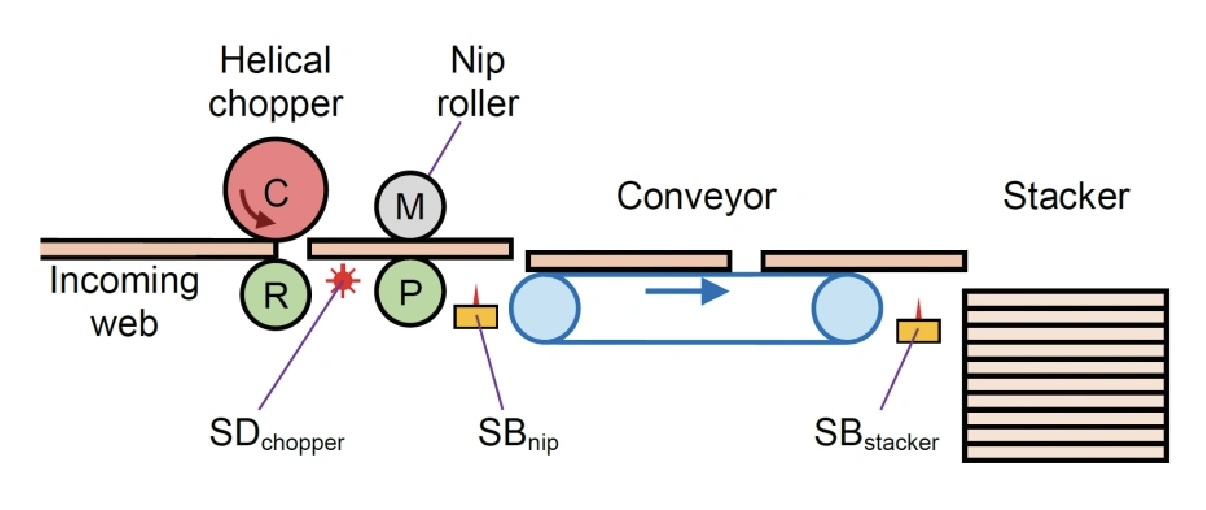Static Control for Pouch, Bag and Label Lines
- Published: November 18, 2024
Solving Pouch Opening Failures and Preventing Stack Bricks
By Dr. Kelly Robinson, Founder, Electrostatic Answers
Pouch, bag and label lines have unique static control challenges. A web is unwound from a master roll, conveyed through a line where one of the steps is chopping the web into individual sheets, pouches or bag. The individual pieces are then stacked. Two common static problems are:
- A finished bag or pouch fails to open.
- A finished product fails to feed from the stack.
Both problems are caused by balanced charges where there are positive charges on one surface and an equal number of negative charges on the other surface. A fieldmeter does not detect balanced charges. Fieldmeter reading Eclosed on the closed bag in Figure 1 is zero because there are equal numbers of positive and negative charges inside control volume CVelosed.

When the balanced charges are too big, the bag won't open. We can diagnose the problem by pulling the bag open. Etop detects the positive charges inside CVtop on the top sheet. Ebot responds to the negative charges on the bottom sheet inside CVbot.
Now that we've verified that balanced charges are causing the bag opening failure, we need to look upstream to solve the problem. Focus first on nip rollers.
The incoming web in Figure 2 is chopped into individual pieces by the helical chopper. A rubber nip roller (R) holds the web against the metal chopper blade (C). A nip roller feeds the chopped pieces onto a conveyor. The conveyor moves the pieces to the stacker.

The rubber chopper roller (R) charges the bottom surface of the chopped pieces. Static dissipator SDchopper exiting the chopper faces the bottom surface that touched the rubber roller. Exiting the chopper is a congested area and there is usually not enough space for a powered static bar.
Install a passive static dissipator like a static brush. While the bristle can lightly touch, the leading edge of the chopped pieces will wear out the brush limiting its service life. Better is to install the static brush close to the chopped pieces with perhaps only occasional contact.
Static dissipator SDchopper must be installed facing the surface that touched the rubber chopper roller (R). In Figure 1, this is the bottom surface. While it may be easier to install SDchopper facing the top surface, the neutralizing ions would deposit on the wrong side creating problems caused by balanced charges.
The polymer nip roller (P) charges the bottom surface. Powered static bar Snip exiting the nip roller faces the bottom surface that touched the polymer roller. The chopped pieces exiting the nip are not well constrained and their trajectory varies. Install a powered static bar that neutralizes charges from a couple of inches away. This allows the chopped pieces to move freely and unobstructed from the nip onto the conveyor.
Powered static bar SBnip must be installed facing the surface that touched the polymer nip rubber roller (P). In Figure 1, this is the bottom surface. While it may seem better to install SBnip above the pieces facing the top surface, the neutralizing ions would deposit on the wrong side creating problems caused by a balanced charge.
The conveyor belts charge the bottom surface especially if the conveyor has vacuum belts. Powered static bar SBstacker exiting the conveyor faces the bottom surface that touched the belts. The chopped pieces exiting the conveyor entering the stacker are not well constrained and their trajectory varies. Install a powered static bar that neutralizes charges from a couple of inches away. This allows the chopped pieces to move freely and unobstructed from the conveyor into the stacker.
Powered static bar SBstacker must be installed facing the surface that touched the conveyor belts. In Figure 1, this is the bottom surface. While it may seem better to install SBstacker above the pieces facing the top surface, the neutralizing ions would deposit on the wrong side creating problems caused by balanced charges.

Next focus on anti-curl bars and folding frames. Wrinkles and curls in the incoming web in Figure 3 are flattened by the fixed anti-curl bar (F). Similarly, the incoming web may be folded to form gussets, bags or pouches by a fixed folding frame (F). In both cases, the web surface that rubs (F) becomes charged.
Static dissipator SDbar exiting the fixed bar (F) faces the bottom surface that touched (F). Exiting a folding frame element is congested and mounting a dissipater is challenging. However, passive static dissipator SDbar must face the surface that touched (F).
Focus on nip rollers, anti-curl bars and folding frames to find the best places to install static eliminators for bag, pouch and label lines. Use high-performance, short-range static bars when there is sufficient space. Otherwise, use passive dissipaters like static brushes or ionizing cords.
About the Author
Dr. Kelly Robinson writes on static issues occurring in converting processes. Robinson founded Electrostatic Answers, has 40-plus years experience in industrial problem solving and was named Top Manufacturing Consulting Services Provider 2023 by Managing MFG. He can be reached at Kelly.Robinson@ElectrostaticAnswers.com.












